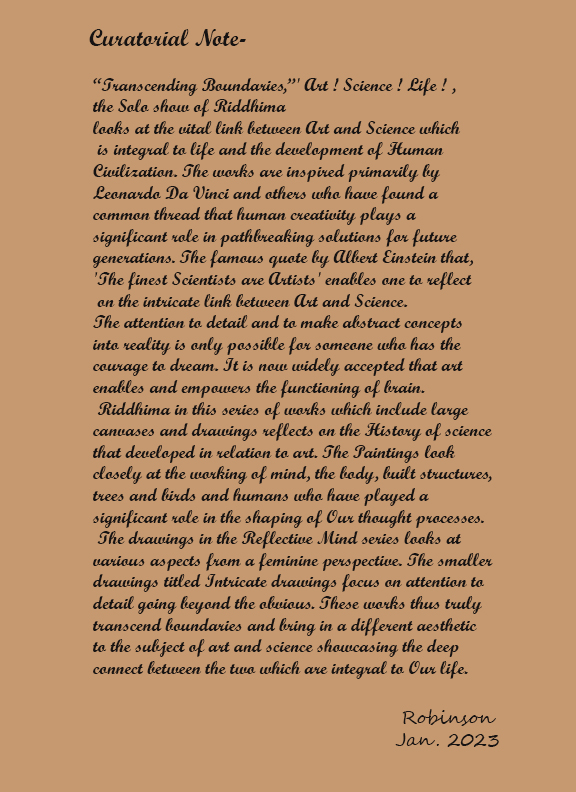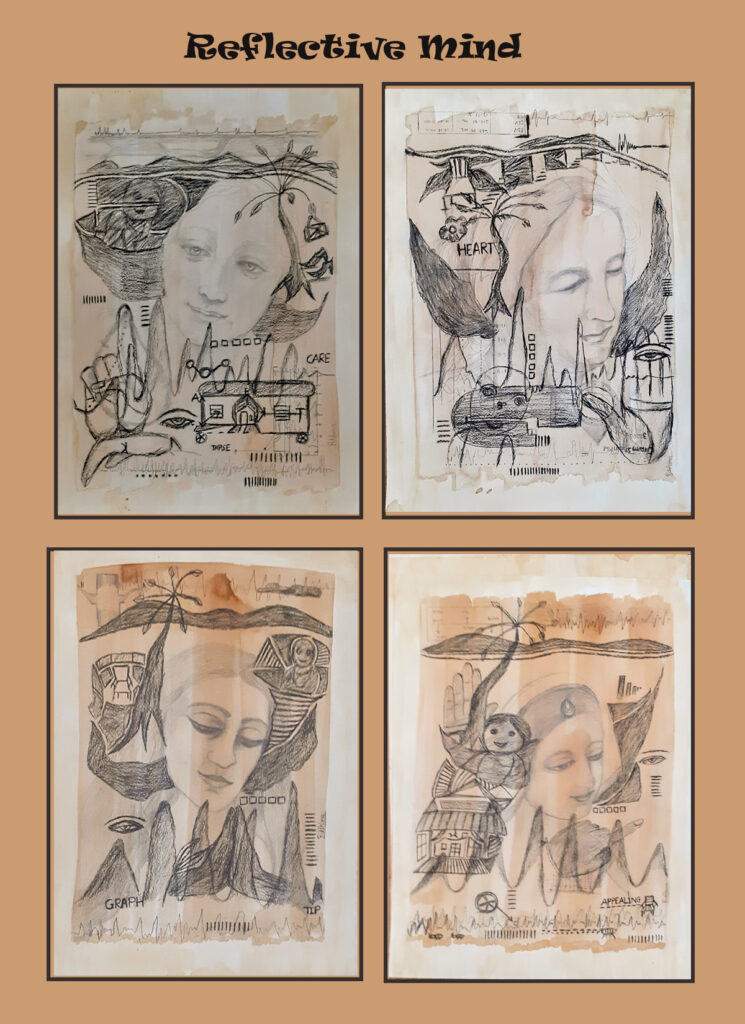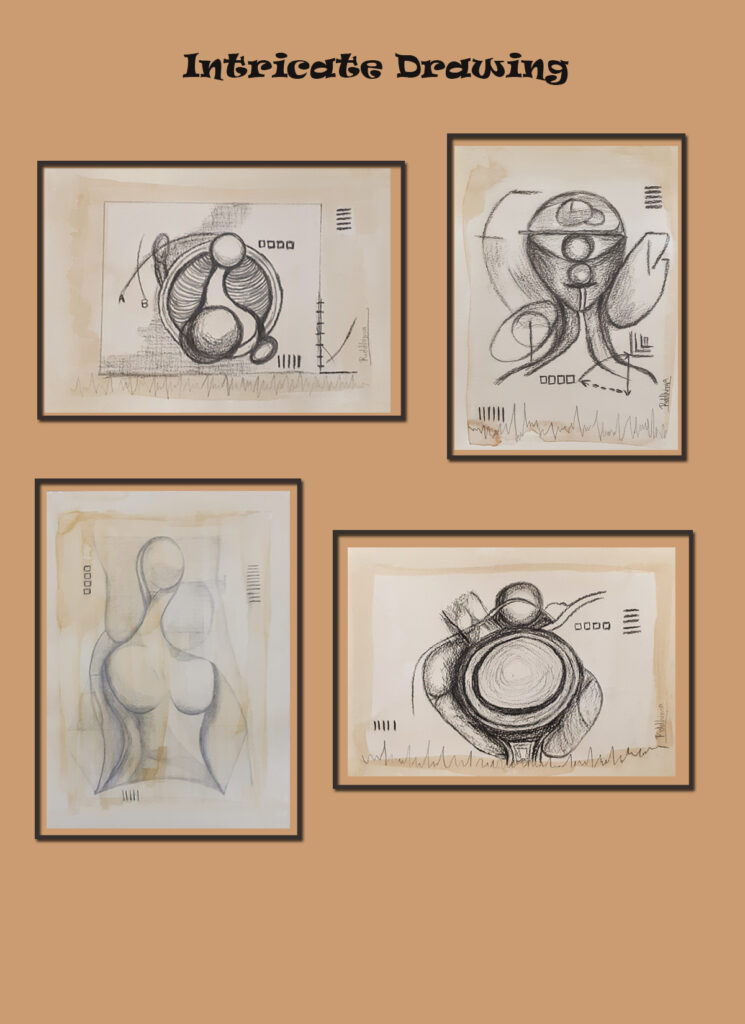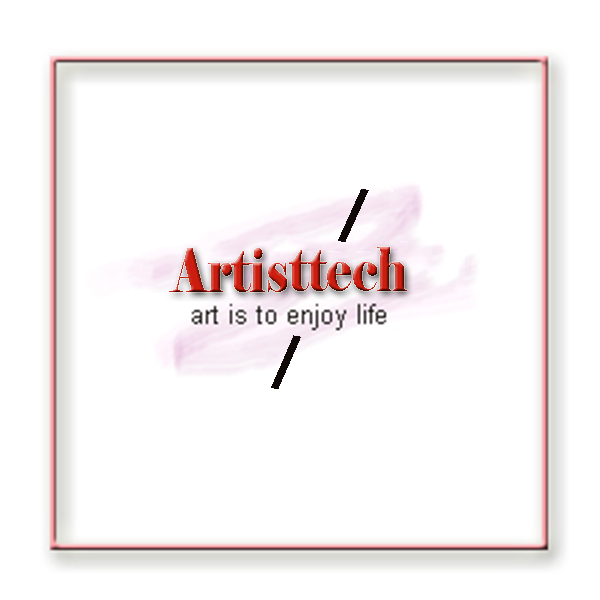‘ Art ! Science ! Life ! ,

Scientific Mind:
Our personality is in a way an extension of our mind, the thoughts, notions and perceptions it carries. Many faces are shown here viewing which any person can know their personality to such an extent that he can understand their mind, that’s why the main character’s face is depicted in the picture instead of the brain. Like all my other paintings, the tree representing nature and other elements have various meanings.
According to Sigmund Freud, the creation of dreams or art is identical. In both, there is a journey beyond daily life. According to him, unsatisfied desires take the form of dreams or art or poetry that looks different from the real world.
An approximately 4300 BC human skull excavated from the ancient Harappan civilization in India represents the world’s oldest (known) successful human brain surgery. Apart from this, a few decades ago, such remains were found in many places of the world and India, which makes it clear that successful operations were definitely done in ancient India. Apart from this, foreigners also practice Bhramari among many other practices. Yoga and other mind exercises were part of Indian thought processes for the development and balance of the brain.
Bird Detail:
The sitting and flying eagle is the witness of that hypothesis from which the hypothesis of parachute or say flight was born. In fact, the laws of nature, whether it is to feel the pressure from flying or to think about flying after seeing the eagle, we have always seen art from nature and science from art and many aspects of life get simplified due to science. Petroglyph art is indicative of how people were inspired and attracted by art knowingly or unknowingly even before science. In this painting, the vertical lines dividing it into two parts are also presenting the flight. Leonardo became interested in flying during his first stay in Milan when he was inspired by youthful enthusiasm; He devoted himself to the design of flying machines with suitable flight feathers to mimic the structure and propulsive movement of birds’ wings. After returning to Florence in the early 1500s, he devoted himself to the observation of birds, studying their flight techniques and body structure. The first parachute was conceived and sketched by Leonardo da Vinci in the 15th century. Hard to believe something as “modern” as a parachute from 500 years ago.
The Beauty of Life:
This Painting endeavors to find and establish the relationship between art, science, and life. In this painting we are throwing light on the development of life i.e. the womb of a child. There is evidence that engravings that are more than 1000 years old clearly show the position of the sperm and the baby in pregnancy, which can only be seen and verified by today’s most advanced technological machines. The sketch here is based on Leonardo’s discovery over 400 years before the advent of machines like ultrasound, which means knowingly or unknowingly the artist can see beyond the limits of time and the works painted by the artist can help in the discovery of science.
Drawings of Leonardo da Vinci’s foetus in the womb and accompanying observational notes are found in the third volume of his personal notebook. The drawings of Leonardo’s Embryonic Study were conducted between1510–1512 and were done in pen and ink on paper, some with black and red chalk and wash. These groundbreaking illustrations of embryos reveal his advanced understanding of human development and demonstrate his role as a pioneer of embryology during the Renaissance. His famous embryological drawings of foetuses have since been collected and held in the Royal Collection at Windsor Castle in England.
Pulsating Heart:
Here we will discuss both the heart that exists in the form of the human organ and the heart of an artist’s art.
Because Leonardo Vinci made very deep discoveries on this subject and those discoveries were confirmed by state-of-the-art equipment after 500 years later, he certainly holds his own in this research report. Although Leonardo has been surprising the whole world with his art, his scientific sketches have been especially inspirational for artists all over the world.
Although most scientific discoveries of the past 300 to 400 years find initial mention in the Vedas. Human physiology, in particular, the circulatory system is one such concept dealt with in the Vedas and later in the Brihat trayee. Not just the organs/structures associated with this system like the Hridaya (heart), Dhamani (arteries), and Shira (veins) but also diseases of the Raktavaha srotas (circulatory system) like clogged arteries have been found description in Rigveda and Yajurveda. Blood, its structure and functions, and its importance as a carrier of nutrients and oxygen to find mentioned. Atharvaveda being the source and origin of Ayurveda is a storehouse of all aspects of health and medicine.
Built Heritage:
This painting depicts through different ‘arcs’ of time and space; the artist wants to establish that not only architecture has a very important place but also define how this arch represents the education and culture of time and general life. Especially India is the world leader in architecture, the architecture of the Indus Valley is world-famous and the arch shown in various pictures is India’s gift to the world.
Leonardo’s greatness is attributed to the vastness and diversity of his knowledge. At the time, and even today, it would be difficult to find someone who could match his deep level of understanding of such a wide range of subjects. With this in mind, it is reasonable to imagine that da Vinci would probably have worked individually as an architect. From drafting and detailing to structural and engineering calculations to the actual execution of the building; this one man would be enough to take care of them all. And there is no doubt that he will be exceptional in all these roles.
The picture of the cover page of the famous book of Architect’s Rules has also been taken in the painting.
Understanding Face Scale:
Here the dimensions of the human body are shown in reality through the dimensions of the head in pictures.
Here, to some extent, it seems that science has assisted art, while ancient Indian texts describe the formation of a tala with 12 fingers, a woman’s body with 7.5 talas, and a man’s body with eight talas. The rules of art described in Indian cinematography are helpful not only in illustration but sometimes in the scientific interpretation of anatomical details such as the Vitruvian Man. However, artists can take advanced scientific data and create immersive images to show these unseen objects.
In all phases of science communication, from childhood interest to secondary education, to professionals and research, illustrators are needed at every step because you can’t explain it without pictures or models.
Gender Empathy:
This painting depicts gender equality. In Vedic form, the concept of Shiv Shakti which is presented here as the main drawing and in the middle, their triangle dedicated to Shiv Shakti is shown, it is a very important ideology for the balance and life of the society, which has been prevalent since the Vedic period. Along with this, the sign of gender equality which is currently in use has also been painted.
Even in the market of art, we see this discrimination clearly, while art has never discriminated, it rises in anyone’s heart and inspires the society.It is interesting that in Indian culture Mother Saraswati is the goddess of art.
Reflective Series:
These works on paper look at the role of Art, Science and life from a feminine perspective bringing to forte numerous contributions and makes one to reflect on the strength of each mind and individual beyond gender.
Intricate Drawings:
These drawings as per the title is self explanatory. These works with a keen attention towards detail looks at the varied aspects of Science and the influence the same has over Our lives.





An artist by nature, an out-of-this-world person,
Even in those things beyond borders,
Something excites these things beyond the horizon,
Know which is the field of ignorance that binds the artist,
By filling the paintbrush, the color engraves these pictures,
Some figures that do not belong to this place,
Ahh! You can call it a lie too,
because you don’t even know it,
Hey even the artist doesn’t know
In this world of dreams,
The artist takes you on a tour of a new world,
Yes, he is an artist who can paint feelings,
from senses to knowledge,
And makes life fragrant with knowledge….

सीमाओं के पार
स्वभाव से ही एक कलाकार इस दुनिया से बाहर का व्यक्ति,
उसमें भी सीमाओं के पार की बातें,
कुछ उत्साहित करती हैं ये क्षितिज से पार की बातें,
जाने कौन सा वह अज्ञान क्षेत्र है जो कलाकार को बांधता है,
तूलिका में भरकर रंग इन चित्रों को उकेरता है,
कुछ आकृतियाँ जो इस जहाँ की है ही नहीं,
आह ! कह सकते हैं आप इसे झूट भी,
क्योंकि आप इसे जानते ही नहीं,
अरे कलाकार भी नहीं जानता,
स्वपनिल इस संसार में,
आपको कलाकार एक नए संसार की सैर कराता है,
जी कलाकार है यह जो रंगो से सवेंदनाओं को,
संवेदनाओं से ज्ञान को,
और ज्ञान से जीवन को महकाता है….
